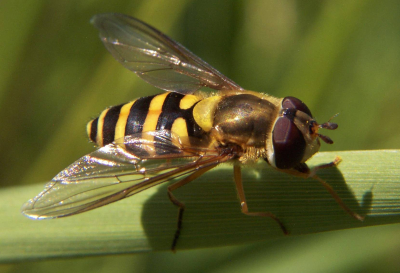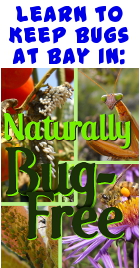
Nectary plants to attract beneficial insects
 In the rush to produce the
world's biggest pumpkin and the world's tastiest strawberries, it's
easy to ignore flowers. But flowering plants should have a
prominent place in any organic garden since they attract beneficial
insects. Everyone knows that ladybugs are the cat's meow, but did
you know that hover flies (also known as syrphid flies) are great
aphid-eaters and that tiny parasitic wasps will eat your pest insects
from the inside out?
In the rush to produce the
world's biggest pumpkin and the world's tastiest strawberries, it's
easy to ignore flowers. But flowering plants should have a
prominent place in any organic garden since they attract beneficial
insects. Everyone knows that ladybugs are the cat's meow, but did
you know that hover flies (also known as syrphid flies) are great
aphid-eaters and that tiny parasitic wasps will eat your pest insects
from the inside out?
The problem with
attracting beneficial insects is that there are a dozen or more key
insect players, and each one needs to be fed supplemental pollen and
nectar all through the growing season. Luckily, many plants
support several different kinds of beneficial insects, especially
plants like umbellifers, composites, and mints that host scores of tiny blooms.
I compiled another spreadsheet to help me keep track of all
of the different nectary plants for beneficial insects, starting with
the ones listed in Robert Kourik's book but expanding out to include
plants listed on Farmer
Fred's website.
It's clear that fennel, goldenrod, and Queen Anne's lace are top
nectary plants, while ragweed appears to be as beloved by some species
as it is by our honeybees. Stay tuned for more nectary musings as
I plan next year's garden.
 This post is part of our lunchtime series reviewing Robert Kourik's Designing and Maintaining your
Edible Landscape Naturally.
Read all of the entries: This post is part of our lunchtime series reviewing Robert Kourik's Designing and Maintaining your
Edible Landscape Naturally.
Read all of the entries:
|
Want more in-depth information? Browse through our books.
Or explore more posts by date or by subject.
About us: Anna Hess and Mark Hamilton spent over a decade living self-sufficiently in the mountains of Virginia before moving north to start over from scratch in the foothills of Ohio. They've experimented with permaculture, no-till gardening, trailersteading, home-based microbusinesses and much more, writing about their adventures in both blogs and books.
Want to be notified when new comments are posted on this page? Click on the RSS button after you add a comment to subscribe to the comment feed, or simply check the box beside "email replies to me" while writing your comment.
